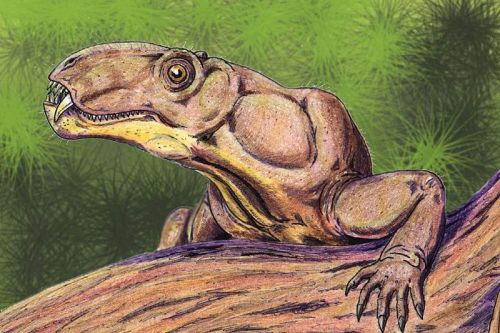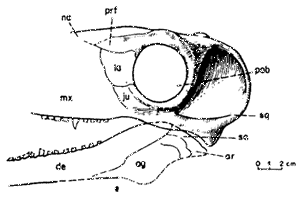
Phthinosuchus - life reconstruction
artwork by Dmitry Bogdanov - Wikipedia
| Therapsida | ||
| The Vertebrates | Therapsida: Phthinosuchidae |
| Vertebrates Home | Vertebrate | Vertebrate |
Abbreviated Dendrogram
Synapsida
│
└─Therapsida
├─Tetraceratops
├─Raranimus
└─┬─?Phthinosuchidae
├─Biarmosuchia
└─┬─Dinocephalia
└─┬─Anomodontia
│ ├─Venyukovioidea
│ └─Dicynodontia
└─Theriodontia
├─Gorgonopsia
└─┬─Therocephalia
└─Cynodontia |
Contents
Index |
 |
Phthinosuchus - life reconstruction artwork by Dmitry Bogdanov - Wikipedia |
 |
 |
Pthinosuchus discors Efremov 1954. = Rhopalodon sp. Seeley 1894, Watson 1921 and 1942, Nopsca 1928). Uralian Cupric Sandstones, Bashkiry, Western Cisuraly, Russia. Early Tatarian (early Capitanian epoch), Middle Permian. Skull in dorsal, palatal & left lateral views, directly above, above right and to the right respectively. Many of the suture lines should not be taken too seriously. Note, inter alia, the extreme posterior position of the pineal foramen and absence of any obvious tabular, quadrate, or occipital bones of any kind. The possibility that this scrappy specimen has also undergone very significant deformation should be considered. |
 |
Under this lugubrious general heading are two very poorly known basal therapsids from the Middle Permian of Russia. They do not seem to be closely related, but in any case are placed (rightly or wrongly) each in their own family. The group "Phthinosuchia" is thus a hodgepodge of a very fragmentary cranium (Phthinosuchus), a wastebasket full of dentary fragments, and a few postcrania which may or may not belong to the same animal. All that can be said is that this scrappy material comes for the most part from animals close to the therapsid stem, perhaps related to the Biarmosuchia. It is vanishingly unlikely that these remains represent valid therapsid lineages. Much more material is required if light is to to be shed on the early rich evolutionary radiation of the Middle Permian therapsids.
Of the two taxa, only a single partial skull is known for the Phthinosuchidae, and it is the more informative of the two. The front part of the snout is lacking. On the right side, only the imprint of bones remains. Overall it is insufficiently prepared and locally hidden by plaster. It is strikingly similar to that of a sphenacodont, but with larger synapsid openings behind the eyes and more prominent canine teeth. It may be intermediate in structure between the pelycosaurs and the therapsids. No postcranial elements have been attributed to this family. The anterior part of the skull illustrated by Seeley has since been lost. The frequent reproductions of Efremov's reconstruction gives the impression that the skull is a more complete than it really is. The images shown here give a more correct representative than that in many textbooks.
This skull has been described in great detail by Tataranov (1974). Even though it is compressed laterally it must have been high and narrow (dare we say it, phthin?), with a convex dorsal profile and a temporal fossa that is higher than wide. The snout was probably high and short. The skull roof is relatively narrow at the level of the large orbits and wide at the level of the temporal fossae. The pineal foramen is marked by a large protruberance and situated near the posterior limit of the cranial roof. The lacrimal is short. Frontal participates broadly in the orbit. The postorbital and temporal arches are thin; the occiput is high and slightly inclined ventro-anteriorly. The mandible is slender, and the dentary does not seem to extend dorsally beyond the level of the surangular. There exist a large number of postcanine teeth. The occiput, from what little one can tell, was wide and high. The mandible was very slender.
This specimen has been described at length a number of times, e.g. by the Russian palaeontologists Efremov in 1954 and Tatarinov in 1974. It was said to be related to the Anteosauria or carnivorous dinocephalians by earlier researchers, such as Seeley and Watson. Nopcsa in 1928 classified it in the gorgonopsians, and was followed in this by Efremov and by Romer. But no gorgonopsian specializations are found, apart from some shared primitive characteristics. Romer, noting the absence of gorgonopsian specializations, used Phthinosuchus to erect the infraorder "Phthinosuchia." Although Carroll (1988) includes the suborder "Phthinosuchia" in his genus list, there is simply no phylogenetic basis for this taxon.
Other Phthinosuchus characters are less suggestive of gorgonopsids than of anteosaurs. For example, the proportions of the skull roof are anteosaurian. However, other anteosaur specializations are absent, such as the narrow intertemporal skull found in the contemporary Archaeosyodon. There is a median suture on the underside (ventral), rather like in Eotitanosuchus. But in all respects, in view of the incomplete state of the specimen and absence of the posteranial skeleton, it is impossible to determine much about its actual relationships with other therapsids.
The other "Phthinosuchian" is Pthinosaurus, and is erected on an even less convincing specimen, a partial lower jaw. About this uninformative. vaguely rectangular object, perhaps the less said the better. Two dentary fragments, a scapula, ulna, and an angular, from the same locality have also been referred to this species. However, we have no information about the basis for this referral and respectfully decline to further perpetuate this mythical taxon.
MAK000802, ATW020518.
Phthinosuchus
Late Permian of Russia.
Therapsida :: (Biarmosuchia + (Eotitanosuchia + Eutherapsida)) + *.
1-2m?; lower jaw slender; coronoid process absent; small temporal fenestra only slightly larger than orbit; slight thickening of dorsal border of orbit; lower jaw articulation displaced anteriorly; occiput saod to be slightly slanted forward dorsally.
Not intended to include Phthinosaurus. The type and referred fragments called Phthinosaurus are sometimes united with Phthinosuchidae in "Phthinosuchia." There is nothing that suggests that this is a clade. In addition, the material of Phthinosaurus is below the (admittedly subjective) scrappiness threshold for inclusion in these Notes.
Comment made in reference to ATW's former site, Vertebrate Notes. Now criteria for inclusion generally hinge on what is published in the professional literature.
RFVS20140704
Lecture 03 - Cont. Drift (odd taxonomy); paleng2_0p189abs; Notes From Other Vertebrates; therapsid2c; RÉPTEIS SINÁPSIDAS Spanish).
ATW011206
checked ATW040305; last modified MAK091114